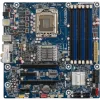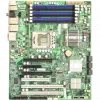LGA 1366, also known as Socket B, is an Intel CPU socket. This socket supersedes Intel's LGA 775 (Socket T) in the high-end and performance desktop segments. It also replaces the server-oriented LGA 771 (Socket J) in the entry level and is superseded itself by LGA 2011. LGA stands for land grid array. This socket has 1,366 protruding pins which touch contact points on the underside of the processor (CPU) and accesses up to three channels of DDR3 memory via the processor's internal memory controller.
Socket 1366 (Socket B) uses QPI to connect the CPU to a reduced-function northbridge that serves mainly as a PCI-Express controller. A slower DMI is used to connect Intel's most recent northbridge and southbridge components. By comparison, Intel's socket 1156 (Socket H) moves the QPI link and PCI-Express controller onto the processor itself, using DMI to interface a single-component "chipset" (now called PCH) that serves traditional southbridge functions. The difference in pin number is mostly a reflection of the number of memory channels served.
In November 2008, Intel released Core i7, which was the first processor requiring this socket. LGA 1366 was replaced by LGA 2011 on November 14, 2011, supporting Sandy Bridge E-series processors. LGA 1366 socket and processors was officially discontinued in 2012.




